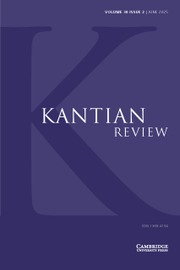Crossref Citations
This article has been cited by the following publications. This list is generated based on data provided by Crossref.
Thielke, Peter
2021.
Kant's Prolegomena.
Goldhaber, Charles
2023.
The Dissatisfied Skeptic in Kant’s Discipline of Pure Reason.
Journal of Transcendental Philosophy,
Vol. 4,
Issue. 2,
p.
157.
Matherne, Samantha
2024.
Seeing More.

